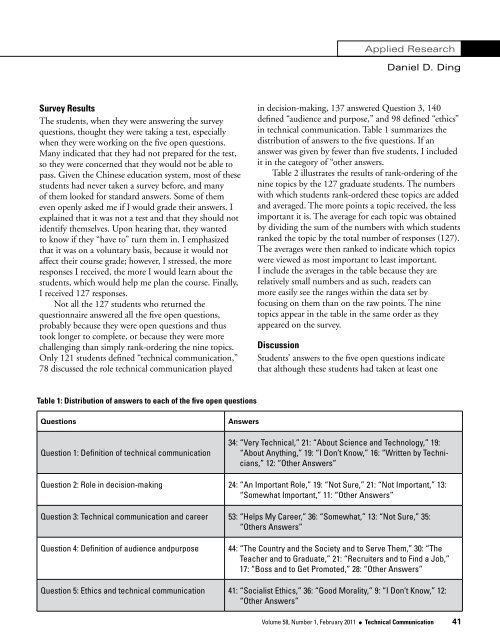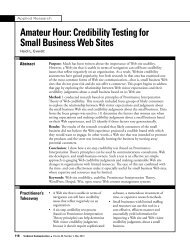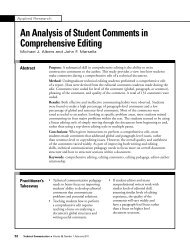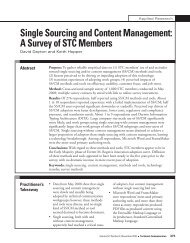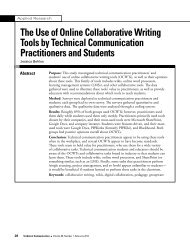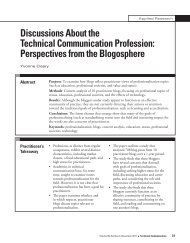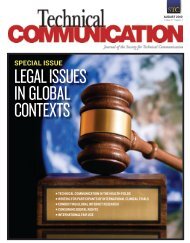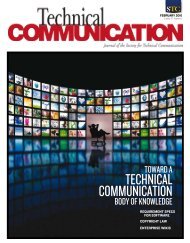When Traditional Chinese Culture Meets a Technical ...
When Traditional Chinese Culture Meets a Technical ...
When Traditional Chinese Culture Meets a Technical ...
Create successful ePaper yourself
Turn your PDF publications into a flip-book with our unique Google optimized e-Paper software.
Applied ResearchDaniel D. DingSurvey ResultsThe students, when they were answering the surveyquestions, thought they were taking a test, especiallywhen they were working on the five open questions.Many indicated that they had not prepared for the test,so they were concerned that they would not be able topass. Given the <strong>Chinese</strong> education system, most of thesestudents had never taken a survey before, and manyof them looked for standard answers. Some of themeven openly asked me if I would grade their answers. Iexplained that it was not a test and that they should notidentify themselves. Upon hearing that, they wantedto know if they “have to” turn them in. I emphasizedthat it was on a voluntary basis, because it would notaffect their course grade; however, I stressed, the moreresponses I received, the more I would learn about thestudents, which would help me plan the course. Finally,I received 127 responses.Not all the 127 students who returned thequestionnaire answered all the five open questions,probably because they were open questions and thustook longer to complete, or because they were morechallenging than simply rank-ordering the nine topics.Only 121 students defined “technical communication,”78 discussed the role technical communication playedin decision-making, 137 answered Question 3, 140defined “audience and purpose,” and 98 defined “ethics”in technical communication. Table 1 summarizes thedistribution of answers to the five questions. If ananswer was given by fewer than five students, I includedit in the category of “other answers.Table 2 illustrates the results of rank-ordering of thenine topics by the 127 graduate students. The numberswith which students rank-ordered these topics are addedand averaged. The more points a topic received, the lessimportant it is. The average for each topic was obtainedby dividing the sum of the numbers with which studentsranked the topic by the total number of responses (127).The averages were then ranked to indicate which topicswere viewed as most important to least important.I include the averages in the table because they arerelatively small numbers and as such, readers canmore easily see the ranges within the data set byfocusing on them than on the raw points. The ninetopics appear in the table in the same order as theyappeared on the survey.DiscussionStudents’ answers to the five open questions indicatethat although these students had taken at least oneTable 1: Distribution of answers to each of the five open questionsQuestionsQuestion 1: Definition of technical communicationAnswers34: “Very <strong>Technical</strong>,” 21: “About Science and Technology,” 19:“About Anything,” 19: “I Don’t Know,” 16: “Written by Technicians,”12: “Other Answers”Question 2: Role in decision-making 24: “An Important Role,” 19: “Not Sure,” 21: “Not Important,” 13:“Somewhat Important,” 11: “Other Answers”Question 3: <strong>Technical</strong> communication and career 53: “Helps My Career,” 36: “Somewhat,” 13: “Not Sure,” 35:“Others Answers”Question 4: Definition of audience andpurpose44: “The Country and the Society and to Serve Them,” 30: “TheTeacher and to Graduate,” 21: “Recruiters and to Find a Job,”17: “Boss and to Get Promoted,” 28: “Other Answers”Question 5: Ethics and technical communication 41: “Socialist Ethics,” 36: “Good Morality,” 9: “I Don’t Know,” 12:“Other Answers”Volume 58, Number 1, February 2011 l <strong>Technical</strong> Communication 41


